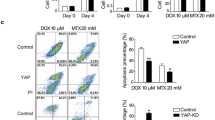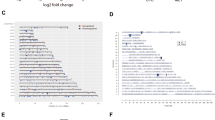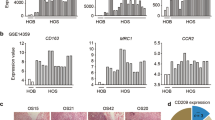Abstract
Background
Osteosarcoma is the most common primary malignancy of the bone, and macrophages play a promotional role during osteosarcoma development and progression. TIPE1 is known to function as a tumor suppressor in diverse cancers by inducing cell arrest and apoptosis. However, the biological function of TIPE1 in osteosarcoma is still unclear.
Purpose
The purpose of this study was to investigate the expression and function of TIPE1 in osteosarcoma.
Methods
In the present study, TIPE1 expression in osteosarcoma cancer cells was determined by qPCR and western blotting. A subcutaneous tumor model was established to investigate the potential anti-tumor activity of TIPE1 in osteosarcoma. Further, flow cytometry, western blotting, immunofluorescence staining, and ELISA were performed to clarify the underlying mechanism by which TIPE1 regulates growth of osteosarcoma.
Results
Our results suggest that TIPE1 is downregulated in osteosarcoma cancer cells, and ectopic expression TIPE1 significantly inhibited osteosarcoma tumor growth in vivo. Furthermore, TIPE1 inhibits the infiltration of macrophages in osteosarcoma tumor by suppressing MCP-1 expression in osteosarcoma cells. Further in vivo study revealed that inhibition of MCP-1/CCR2 axis by Bindarit blocked the inhibitory effect of TIPE1 on osteosarcoma growth.
Conclusion
Collectively, our results demonstrate the anti-tumor role of TIPE1 in osteosarcoma and reveal a novel therapy target for osteosarcoma.





Similar content being viewed by others
Data availability
Data and materials supporting the findings of this study are available within the article.
References
Siegel RL, Miller KD, Jemal A. Cancer Statistics, 2017. CA Cancer J Clin. 2017;67(1):7–30. https://doi.org/10.3322/caac.21387.
Siegel RL, Miller KD, Jemal A. Cancer statistics, 2016. CA Cancer J Clin. 2016;66(1):7–30. https://doi.org/10.3322/caac.21332.
Hawkins DS, Arndt CA. Pattern of disease recurrence and prognostic factors in patients with osteosarcoma treated with contemporary chemotherapy. Cancer. 2003;98(11):2447–56. https://doi.org/10.1002/cncr.11799.
Bielack SS, Kempf-Bielack B, Branscheid D, Carrle D, Friedel G, Helmke K, et al. Second and subsequent recurrences of osteosarcoma: presentation, treatment, and outcomes of 249 consecutive cooperative osteosarcoma study group patients. J Clin Oncol. 2009;27(4):557–65. https://doi.org/10.1200/jco.2008.16.2305.
Rivera-Valentin RK, Zhu L, Hughes DP. Bone sarcomas in pediatrics: progress in our understanding of tumor biology and implications for therapy. Paediatr Drugs. 2015;17(4):257–71. https://doi.org/10.1007/s40272-015-0134-4.
Biermann JS, Chow W, Reed DR, Lucas D, Adkins DR, Agulnik M, et al. NCCN Guidelines Insights: bone Cancer, Version 2.2017. J Natl Compr Cancer Netw: JNCCN. 2017;15(2):155–67.
Marx J. Cancer biology. All in the stroma: cancer’s Cosa Nostra. Science (New York, NY). 2008;320(5872):38–41. https://doi.org/10.1126/science.320.5872.38.
Yuan Y, Jiang YC, Sun CK, Chen QM. Role of the tumor microenvironment in tumor progression and the clinical applications (review). Oncol Rep. 2016;35(5):2499–515. https://doi.org/10.3892/or.2016.4660.
Casey SC, Amedei A, Aquilano K, Azmi AS, Benencia F, Bhakta D, et al. Cancer prevention and therapy through the modulation of the tumor microenvironment. Semin Cancer Biol. 2015;35:S199–223. https://doi.org/10.1016/j.semcancer.2015.02.007.
Rhee I. Diverse macrophages polarization in tumor microenvironment. Arch Pharmacal Res. 2016;39(11):1588–96. https://doi.org/10.1007/s12272-016-0820-y.
Kim J, Bae JS. Tumor-associated macrophages and neutrophils in tumor microenvironment. Mediat Inflamm. 2016;2016:6058147. https://doi.org/10.1155/2016/6058147.
Wu X, Ma Y, Cheng J, Li X, Zheng H, Jiang L, et al. TIPE1 function as a prognosis predictor and negative regulator of lung cancer. Oncotarget. 2017;8(45):78496–506. https://doi.org/10.18632/oncotarget.19655.
Zhang Z, Liang X, Gao L, Ma H, Liu X, Pan Y, et al. TIPE1 induces apoptosis by negatively regulating Rac1 activation in hepatocellular carcinoma cells. Oncogene. 2015;34(20):2566–74. https://doi.org/10.1038/onc.2014.208.
Liu W, Chen Y, Xie H, Guo Y, Ren D, Li Y, et al. TIPE1 suppresses invasion and migration through down-regulating Wnt/beta-catenin pathway in gastric cancer. J Cell Mol Med. 2017. https://doi.org/10.1111/jcmm.13362.
Livak KJ, Schmittgen TD. Analysis of relative gene expression data using real-time quantitative PCR and the 2–ΔΔCT method. Methods (San Diego, Calif). 2001;25(4):402–8. https://doi.org/10.1006/meth.2001.1262.
Dai L, Cui X, Zhang X, Cheng L, Liu Y, Yang Y, et al. SARI inhibits angiogenesis and tumor growth of human colon cancer through directly targeting ceruloplasmin. Nat Commun. 2016;7:11996. https://doi.org/10.1038/ncomms11996.
Kumar V, Patel S, Tcyganov E, Gabrilovich DI. The nature of myeloid-derived suppressor cells in the tumor microenvironment. Trends Immunol. 2016;37(3):208–20. https://doi.org/10.1016/j.it.2016.01.004.
Xiao Q, Zhang X, Wu Y, Yang Y. Inhibition of macrophage polarization prohibits growth of human osteosarcoma. Tumor Biol. 2014;35(8):7611–6. https://doi.org/10.1007/s13277-014-2005-y.
Segaliny AI, Mohamadi A, Dizier B, Lokajczyk A, Brion R, Lanel R, et al. Interleukin-34 promotes tumor progression and metastatic process in osteosarcoma through induction of angiogenesis and macrophage recruitment. Int J Cancer. 2015;137(1):73–85. https://doi.org/10.1002/ijc.29376.
Kimura Y, Sumiyoshi M, Baba K. Antitumor and antimetastatic activity of synthetic hydroxystilbenes through inhibition of lymphangiogenesis and M2 macrophage differentiation of tumor-associated macrophages. Anticancer Res. 2016;36(1):137–48.
Han Q, Shi H, Liu F. CD163(+) M2-type tumor-associated macrophage support the suppression of tumor-infiltrating T cells in osteosarcoma. Int Immunopharmacol. 2016;34:101–6. https://doi.org/10.1016/j.intimp.2016.01.023.
Wolfs IM, Donners MM, de Winther MP. Differentiation factors and cytokines in the atherosclerotic plaque micro-environment as a trigger for macrophage polarisation. Thromb Haemost. 2011;106(5):763–71. https://doi.org/10.1160/th11-05-0320.
Zou K, Wang Y, Hu Y, Zheng L, Xu W, Li G. Specific tumor-derived CCL2 mediated by pyruvate kinase M2 in colorectal cancer cells contributes to macrophage recruitment in tumor microenvironment. Tumor Biol. 2017;39(3):1010428317695962. https://doi.org/10.1177/1010428317695962.
Hultgren EM, Patrick ME, Evans RL, Stoos CT, Egland KA. SUSD2 promotes tumor-associated macrophage recruitment by increasing levels of MCP-1 in breast cancer. PLoS One. 2017;12(5):e0177089. https://doi.org/10.1371/journal.pone.0177089.
Chen Q, Sun W, Liao Y, Zeng H, Shan L, Yin F, et al. Monocyte chemotactic protein-1 promotes the proliferation and invasion of osteosarcoma cells and upregulates the expression of AKT. Mol Med Rep. 2015;12(1):219–25. https://doi.org/10.3892/mmr.2015.3375.
Acknowledgments
The present study was supported by Natural Science Foundation of Jiangsu Province (BK20161069).
Author information
Authors and Affiliations
Contributions
PC and JCZ were involved in the acquisition of the data. JML and QZ were involved in the analysis and interpretation of the data. QZ was involved in the conception and design of the present study.
Corresponding author
Ethics declarations
Conflict of interest
The authors declare that they have no conflict of interest.
Ethical approval
All procedures performed in studies involving human participants were in accordance with the ethical standards of the institutional and/or national research committee and with the 1964 Helsinki Declaration and its later amendments or comparable ethical standards.
Informed consent
Informed consent was obtained from all individual participants included in the study.
Rights and permissions
About this article
Cite this article
Chen, P., Zhou, J., Li, J. et al. TIPE1 suppresses osteosarcoma tumor growth by regulating macrophage infiltration. Clin Transl Oncol 21, 334–341 (2019). https://doi.org/10.1007/s12094-018-1927-z
Received:
Accepted:
Published:
Issue Date:
DOI: https://doi.org/10.1007/s12094-018-1927-z




